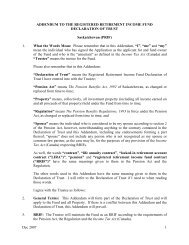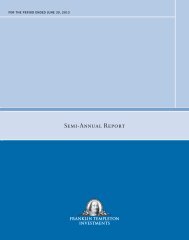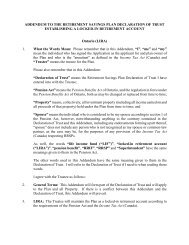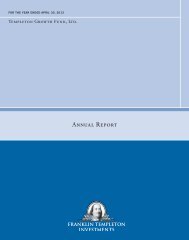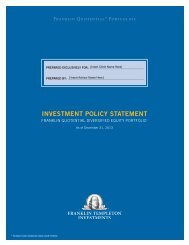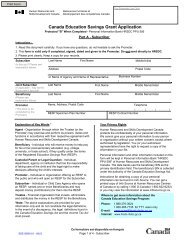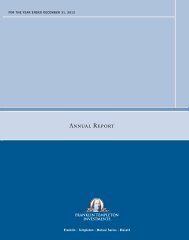CONSOLIDATED STATEMENTS OF CASH FLOWS[Table continued from previous page](in thousands)for the fiscal years ended September 30, 2009 2008 2007Components of Cash and Cash EquivalentsCash and cash equivalents, beginning of year:Current assets ........................................ $2,314,818 $3,304,495 $3,310,545Banking/finance assets ................................. 212,734 279,688 302,590Total .................................................. $2,527,552 $3,584,183 $3,613,135Cash and cash equivalents, end of year:Current assets ........................................ $2,982,539 $2,314,818 $3,304,495Banking/finance assets ................................. 121,912 212,734 279,688Total .................................................. $3,104,451 $2,527,552 $3,584,183Supplemental Disclosure of Non-Cash InformationChange in assets related to the net deconsolidation of certainsponsored investment products ............................ $ (379,022) $ (863,200) $ (208,047)Change in liabilities related to the net deconsolidation of certainsponsored investment products ............................ (176,891) (118,780) (38,239)Assets held for sale reclassified from investing to operatingactivities .............................................. — — 9,535Supplemental Disclosure of Cash Flow InformationCash paid for income taxes ................................. $ 395,551 $ 614,021 $ 586,587Cash paid for interest ...................................... 9,382 42,812 39,487See Notes to Consolidated Financial Statements.72
NOTES TO CONSOLIDATED FINANCIAL STATEMENTSNote 1 – Significant Accounting PoliciesBusiness. Franklin Resources, Inc. (“Franklin”) is a holding company that, together with its varioussubsidiaries (collectively, the “Company”) is referred to as Franklin Templeton Investments. The Companyderives substantially all of its operating revenues and net income from providing investment management,fund administration, shareholder services, transfer agency, underwriting, distribution, custodial, trustee andother fiduciary services (collectively, “investment management and related services”) to funds andinstitutional, high net-worth and separately-managed accounts (collectively, the “sponsored investmentproducts”). The Company also offers select retail banking, private banking and consumer lending servicesthrough its banking/finance segment. Services to the sponsored investment products are provided undercontracts that set forth the level and nature of the fees to be charged for these services. The majority of theCompany’s revenues relate to mutual fund products that are subject to contracts that are periodicallyreviewed and approved by each mutual fund’s board of directors/trustees and/or its shareholders.Basis of Presentation. The consolidated financial statements are prepared in accordance withaccounting principles generally accepted in the United States of America, which require the use ofestimates, judgments, and assumptions that affect the reported amounts of assets and liabilities at the date ofthe financial statements and the reported amounts of revenues and expenses during the periods presented.Management believes that the accounting estimates are appropriate and the resulting balances arereasonable; however, due to the inherent uncertainties in making estimates, actual amounts may differ fromthese estimates. Certain comparative amounts for prior fiscal years have been reclassified to conform to thefinancial statement presentation as of and for the fiscal year ended September 30, 2009 (“fiscal year 2009”).The Company has evaluated subsequent events through November 24, 2009, which is the date that thisAnnual Report on Form 10-K is filed with the U.S. Securities and Exchange Commission (the “SEC”).Consolidation. The consolidated financial statements include the accounts of Franklin and itssubsidiaries in which it has a controlling financial interest. An entity generally is considered to have acontrolling financial interest when it owns a majority of the voting interest in an entity. The Company alsoconsolidates any variable interest entity (“VIE”) for which it is considered the primary beneficiary. Allmaterial intercompany accounts and transactions have been eliminated.A VIE is an entity in which the equity investment holders have not contributed sufficient capital tofinance its activities or the equity investment holders do not have defined rights and obligations normallyassociated with an equity investment. An entity that has the majority of the risks and rewards of ownershipof a VIE, referred to as the primary beneficiary, is required to consolidate the VIE.The Company evaluates whether entities are VIEs and determines if it qualifies as the primarybeneficiary of the VIEs. The Company’s VIEs primarily include certain sponsored investment products andcertain other investment products in which the Company holds an equity ownership interest. Other VIEsinclude limited liability partnerships, limited liability companies, and joint ventures. The form of variableinterests that the Company has in VIEs generally includes equity ownership interest and investmentmanagement and related service fees earned from the sponsored investment products. The evaluation ofwhether the Company qualifies as the primary beneficiary of VIEs is highly complex and involvessignificant judgments, estimates and assumptions. The Company generally utilizes expected cash flowscenarios to determine its interest in the expected losses or residual returns of the VIEs from the investmentmanagement and related service fees or equity ownership interests held. The key estimates and assumptionsused in the analyses include the amount of assets under management, investment management and relatedservice fee rates, the life of the investment product, and the discount rate.73
- Page 1 and 2:
G A I N F R O M O U R P E R S P E C
- Page 3 and 4:
Letter to StockholdersGregory E. Jo
- Page 5 and 6:
LETTER TO STOCKHOLDERSHaving announ
- Page 7 and 8:
Directors and OfficersDirectorsChar
- Page 9 and 10:
Performance GraphThe following perf
- Page 11 and 12:
(MARK ONE)UNITED STATESSECURITIES A
- Page 14 and 15:
operational and other services requ
- Page 16 and 17:
A. Assets Under Management (“AUM
- Page 18 and 19:
60 days. If agreements representing
- Page 20 and 21:
Similar arrangements exist with the
- Page 22 and 23:
We generally operate our institutio
- Page 24 and 25:
Franklin Templeton Variable Insuran
- Page 26 and 27:
CATEGORY(and approximate amount of
- Page 28 and 29:
The following table sets forth the
- Page 30 and 31:
Korea; the Commission de Surveillan
- Page 32 and 33: COMPETITIONThe financial services i
- Page 34 and 35: or other efforts successfully stabi
- Page 36 and 37: and, consequently, we are incurring
- Page 38 and 39: such as information, systems and te
- Page 40 and 41: like our business, is based in part
- Page 42 and 43: orrowing costs and limit our access
- Page 44 and 45: director of various subsidiaries of
- Page 46 and 47: PART IIItem 5. Market for Registran
- Page 48 and 49: OverviewWe are a global investment
- Page 50 and 51: Net income decreased in fiscal year
- Page 52 and 53: Investment Management Fee RateThe f
- Page 54 and 55: accounts closed in a calendar year
- Page 56 and 57: Information Systems, Technology and
- Page 58 and 59: Our investments in sponsored invest
- Page 60 and 61: At September 30, 2009, we had $355.
- Page 62 and 63: Off-Balance Sheet ArrangementsAs of
- Page 64 and 65: The fair value of retained subordin
- Page 66 and 67: Indefinite-lived intangible assets
- Page 68 and 69: the position will be sustained upon
- Page 70 and 71: Selected Quarterly Financial Data (
- Page 72 and 73: The following is a summary of the e
- Page 74 and 75: Item 8.Financial Statements and Sup
- Page 76 and 77: REPORT OF INDEPENDENT REGISTERED PU
- Page 78 and 79: CONSOLIDATED BALANCE SHEETS(dollars
- Page 80 and 81: CONSOLIDATED STATEMENTS OF STOCKHOL
- Page 84 and 85: Fair Value Measurements. The Compan
- Page 86 and 87: Company held interest-rate swap agr
- Page 88 and 89: not performed. If the carrying valu
- Page 90 and 91: Accumulated Other Comprehensive Inc
- Page 92 and 93: acquisition cost was allocated to t
- Page 94 and 95: FHLB borrowings and amounts availab
- Page 96 and 97: The Company recognized other-than-t
- Page 98 and 99: The changes in Level 3 assets measu
- Page 100 and 101: Changes in the allowance for loan l
- Page 102 and 103: Company sold retained subordinated
- Page 104 and 105: Certain of the goodwill and intangi
- Page 106 and 107: At September 30, 2009, maturities o
- Page 108 and 109: The components of the net deferred
- Page 110 and 111: At September 30, 2009, the banking/
- Page 112 and 113: Total assets under management of in
- Page 114 and 115: Stock OptionsThe following table su
- Page 116 and 117: The following tables summarize info
- Page 118 and 119: Operating revenues of the banking/f
- Page 120 and 121: minimum Tier 1 and Total risk-based
- Page 122 and 123: PART IIIItem 10. Directors, Executi
- Page 124 and 125: Item 15.(a)(1)(a)(2)(a)(3)PART IVEx
- Page 126 and 127: Exhibit No.Description10.17 Represe
- Page 128 and 129: Exhibit No.Description12 Computatio
- Page 130 and 131: Exhibit No.DescriptionEXHIBIT INDEX
- Page 132 and 133:
Exhibit No.Description10.22 Amendme
- Page 134 and 135:
(dollars in thousands)COMPUTATION O
- Page 136 and 137:
NameState or Nation ofIncorporation
- Page 138 and 139:
CONSENT OF INDEPENDENT REGISTERED P
- Page 140 and 141:
EXHIBIT 31.2CERTIFICATIONI, Kenneth
- Page 142 and 143:
CERTIFICATION PURSUANT TO 18 U.S.C.
- Page 144:
One Franklin ParkwaySan Mateo, CA 9



